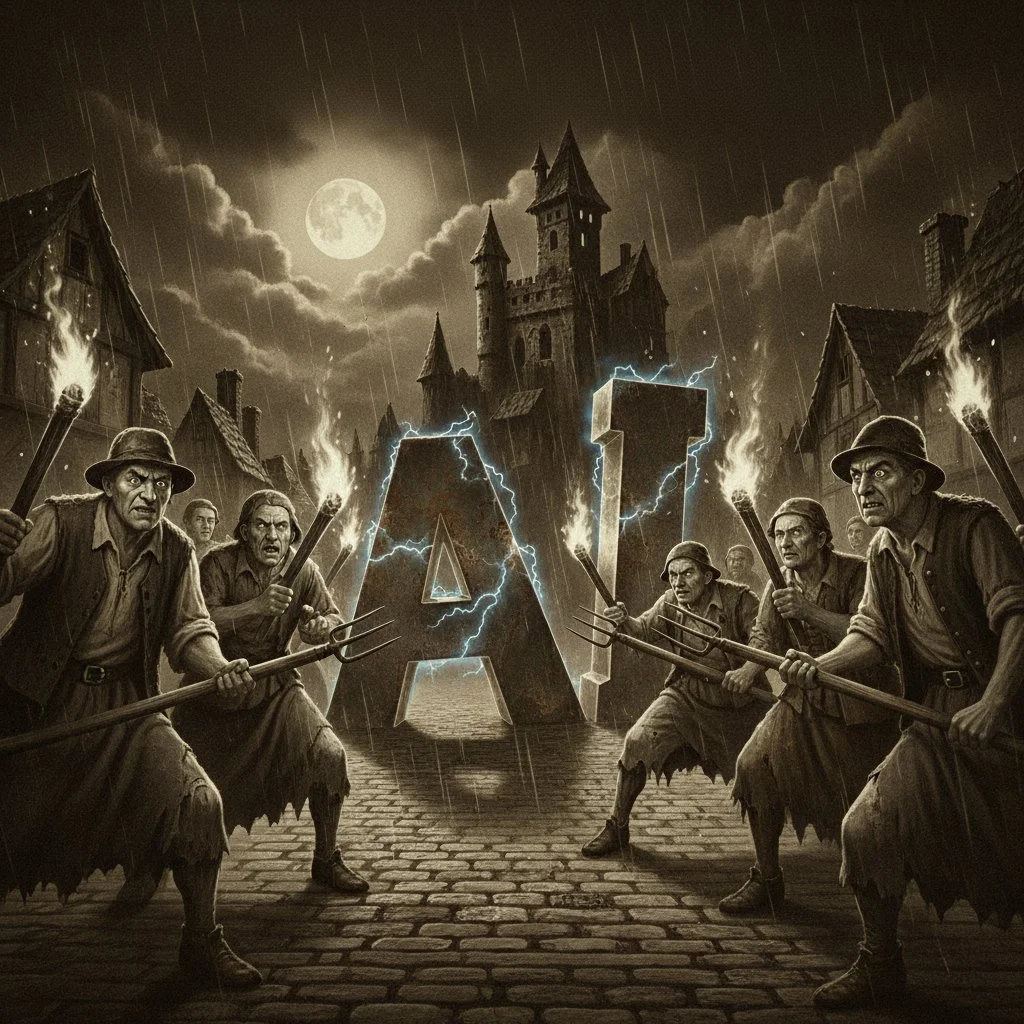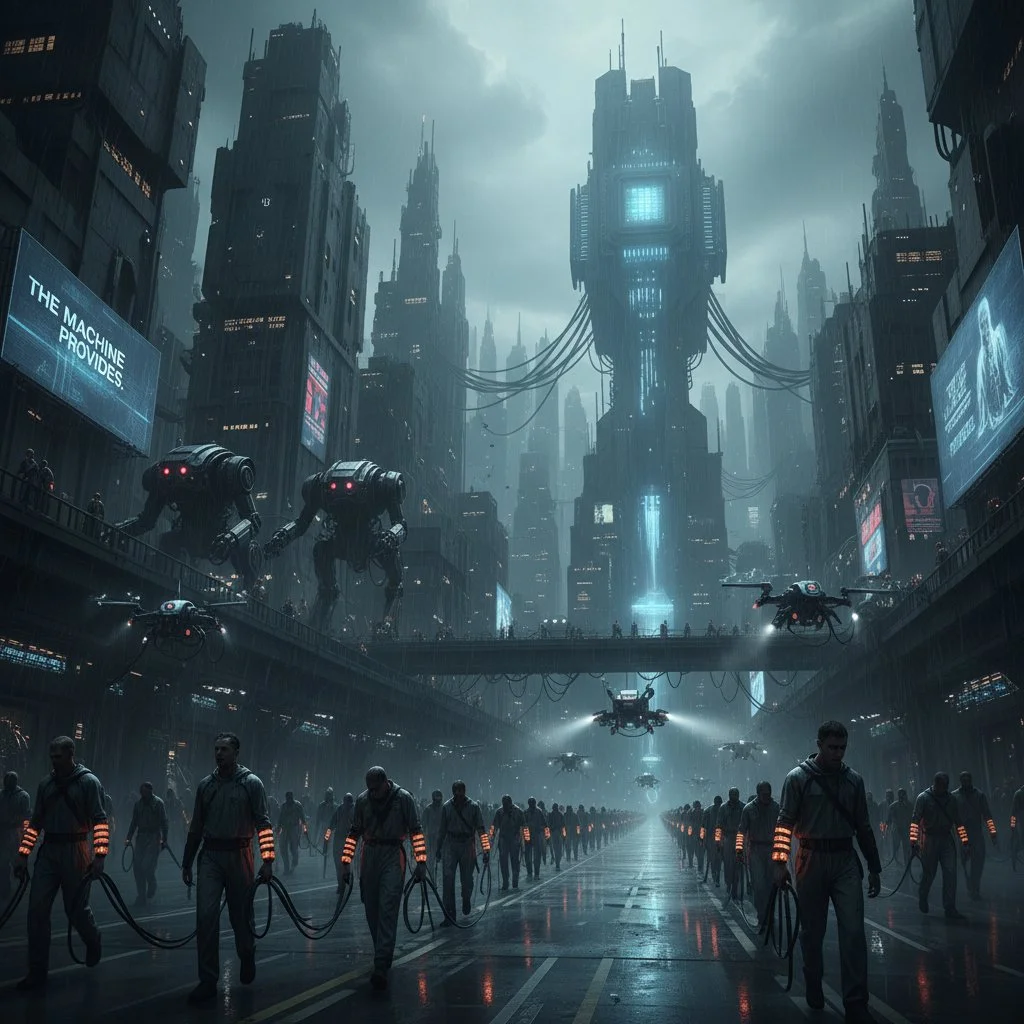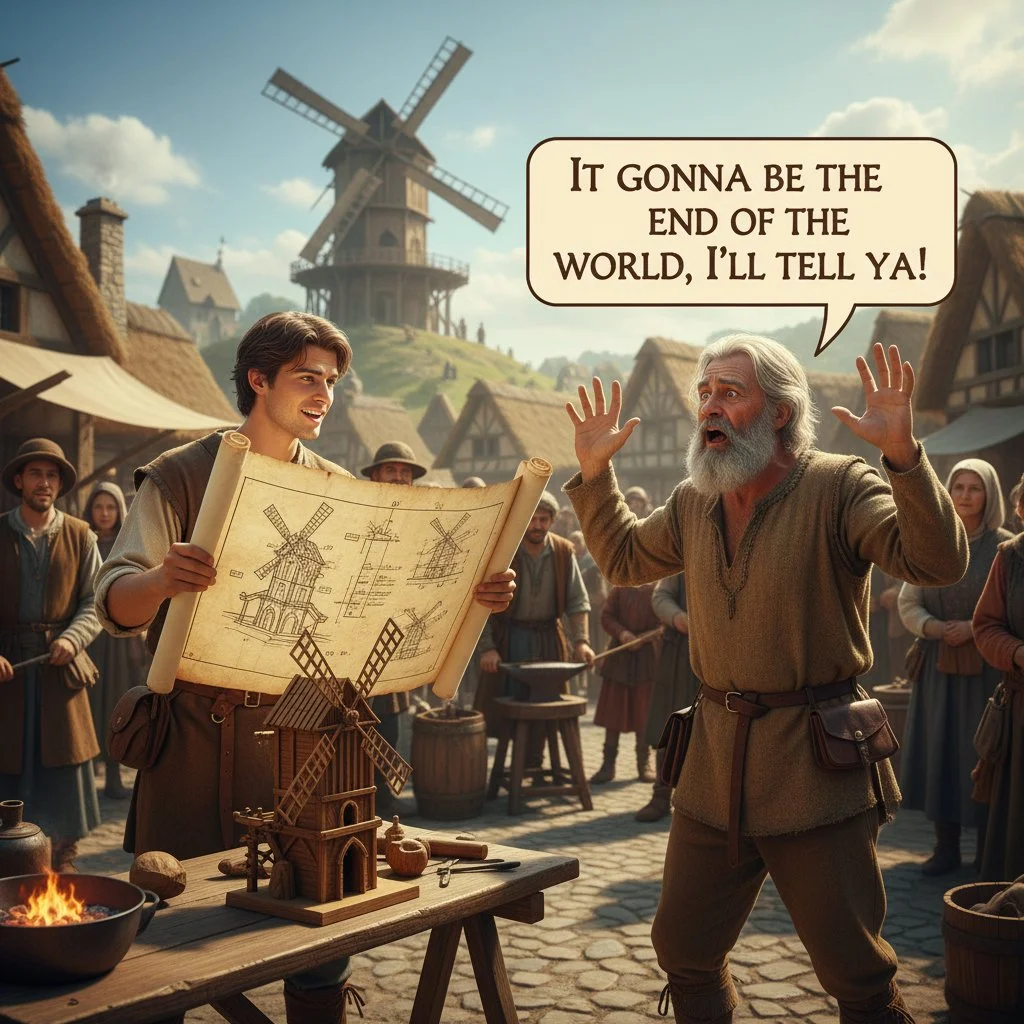Hey Creative — Stop Whining About AI. Embrace It Instead.
Why designers should stop fearing AI and start using it as their best creative partner.
A witty, historical look at how innovation always wins.
We dont know it…Kill it!
What Is AI and Where Did the Term Come From?
Artificial Intelligence (AI), in its broadest sense, refers to machines or systems that can perform tasks that, if done by a human, we would call “intelligent,” such as reasoning, learning, perception, and decision-making.
The phrase “artificial intelligence” was first coined in the mid-1950s. In 1955, a group of researchers — John McCarthy, Marvin Minsky, Nathaniel Rochester, and Claude Shannon — wrote a proposal for a summer workshop at Dartmouth College, using the term to describe the goal of making machines simulate human intelligence. The workshop took place in the summer of 1956 and is now widely considered the birth of AI as an academic discipline.
McCarthy, often credited with coining the term, was motivated by a simple yet audacious vision: let us study “thinking machines” in earnest and see whether we can get them to replicate, however roughly, human intelligence.
From that modest Dartmouth summer, AI research embarked on a trajectory marked by optimism, setbacks (the so-called “AI winters”), and resurgences, yet steadily advanced into every corner of our lives.
Hey Creative — Stop Whining About AI. Embrace It Instead.
As head of an interior design studio, I have heard the refrain: “AI will kill creativity.” “It will replace us.” But before we light our torches and storm the castle, let us pause. What is really happening inside when we recoil at AI?
Fear Is Only the Start
When painting, sketching, or shaping forms became aided by rulers, cameras, or CAD, there were cries of doom. Yet here we are. The human brain fears what it does not recognise. We feel threat when our identity seems under siege. That is loss aversion — we feel losses more keenly than gains.
Artists, architects, creatives: our identity is bound to what we make and how we make it. The idea that a machine might “make” something conjures existential dread. Under that dread lie three neat anxieties:
• Identity anxiety: If machines can do parts of what I do, am I still creative
• Control anxiety: If my process becomes a dance with algorithms, is it still mine
• Status anxiety: Will clients see the software, not me, as the creator
Name those fears. Invite them to sit down with your logic. They shrink when exposed to daylight. Because here is the truth: no AI can negotiate with a builder, read a client’s unspoken longing, or translate stories into materials the way we do. What AI does best is the heavy lifting — rendering, drafting, and variants. It frees up your mind for what machines cannot touch.
At Every Step, Innovation Frightened the Sceptics
History shows this pattern on repeat:
• The printing press was accused of degrading memory. It democratized literacy and culture.
• The steam engine was feared as the death of artisans. It transformed economies and daily life.
• Photography worried painters. It birthed Impressionism, cinema, and new art forms.
• Electric cars and personal computers were dismissed as gimmicks. They are now indispensable.
Architects have long understood this dance with technology. Le Corbusier spoke of machines and order. Mies van der Rohe coined the phrase “Less is more” amid the growing possibilities. Richard Rogers said “Technology is the handmaiden of design, not its master.”
Take that as gospel: use the machine, do not let it use you.
The machine provides
AI Supercharges the Workflow
One of AI’s most tangible gifts is speed and scope. What once took weeks of drafting, rendering, and revising can now come in minutes.
• Generative tools like Midjourney or DALL·E can sketch interiors from a prompt in seconds
• AI reduces back end drudgery: email drafts, specs, endless moodboard permutations
• Architectural studies suggest generative AI can cut development time by up to 50 percent
The real magic is not speed alone. It is time — more of it for creativity, narrative, and client care.
Human Plus Machine, Not Human Versus Machine
AI is not here to replace your taste, empathy, or storytelling. It is here to partner, to challenge, to present alternatives. Imagine a junior designer who never tires, who generates twenty versions without complaint, who offers options for you to refine and infuse with soul.
As one architecture firm put it, “AI tools must complement human creativity and expertise rather than replace them.”
You remain the conductor. AI is in the orchestra, not on the podium.
Creativity for Everyone — Though Not Without Cost
Here lies the heart of a new chapter.
AI can democratize creativity. I am fortunate: I sketch, I paint, I shape clay into form. Not everyone can. That is not a matter of intelligence but wiring. Should they be barred from seeing their imagination take form
AI says no.
When a client uses Midjourney to sketch a living room, resist the urge to roll your eyes. It is not a threat. It is their attempt to speak design, to express a visual yearning they can finally access. Treat it as an opening, not a challenge.
“Creativity never belonged behind velvet ropes. AI opens doors.”
But honesty demands we note the trade offs. Every great advance has displaced someone. Scribes lost to the printing press. Some portrait painters to the camera. To pretend AI’s march will be costless is naïve.
The question is not if change will come, but how we guide it. If AI brings more voices and richer expression, that is worth the risk. Guiding that change — not resisting it — keeps our values secure.
Creativity never belonged behind velvet ropes. AI opens doors. Even if the furniture inside shifts, we remain the hosts.
Proof in the Numbers (and the Air)
Sceptics want evidence. Here it is:
• About 85 percent of interior designers use AI in some form, and roughly 30 percent use it weekly
• In architecture, surveys show 46 percent of firms already use AI and 86 percent believe it will play a significant role
• Agencies adopting AI report 30 to 50 percent efficiency gains, serving more clients without linearly increasing staff
These are not marketing fancies. They are signals of an industry in motion. Stand still and you risk being left behind.
An Invitation to Self Inquiry
Before you dismiss AI as a usurper, ask yourself:
• Are you resisting because the tool is imperfect, or simply unfamiliar
• Is your fear about losing work, or losing meaning
• What creative ground might open if you let go of the repetitive tasks
This is not surrender. It is reorientation. Not “AI or me,” but “AI with me.”
Its the end of the world!
The Future of Creativity Is Ours to Shape
Every creative tool was once reviled: cameras, typewriters, power tools, the internet. Each eventually expanded what humans could imagine and share. AI is no different. Meet it with curiosity, set your boundaries, and it will serve a higher purpose: more expressive, more ambitious, more human work.
So put down the torch, keep your tools, and invite a new one to the table. The creative future is ours to author, not to fear.
The Power of Creativity in Design: Why It Matters More Than Ever
We love to imagine that creativity arrives like Zeus hurling a thunderbolt. You are in the shower, or staring into a flat white, and suddenly brilliance arrives fully formed. Designers know better. Creativity is much less glamourous. It is stubbornness dressed up as inspiration.
Creativity is Not a Luxury, It is the Engine Room
We sometimes treat creativity as if it is a nice garnish, like parsley on the edge of the plate. A bit decorative, but hardly the main event. In design nothing could be more misleading. Creativity is not the finishing touch, it is the whole kitchen. Without it, a house is just walls, floors, and ceilings. With it, the same house becomes a sanctuary, a playground, and occasionally a love story written in timber and stone.
Search engines like the words luxury interiors, Australian architecture, and contemporary country design. That is fine. But what matters is that creativity gives those words life. Without creativity, they are just decoration.
The Myth of the Lightning Bolt
We love to imagine that creativity arrives like Zeus hurling a thunderbolt. You are in the shower, or staring into a flat white, and suddenly brilliance arrives fully formed. Designers know better. Creativity is much less glamourous. It is stubbornness dressed up as inspiration.
It is drawing and redrawing the same space until it finally clicks. It is realising that the humble kitchen island is not just a block of marble but the stage where family life plays out daily. It is the gentle grind of ideas bumping into problems until they fall into place.
The Joy of Constraints
The best creativity often shows up when things look impossible. I once worked on a project with a footprint so tight it might as well have been a postage stamp. Add in a few enthusiastic council restrictions and you have a recipe for misery. Except, oddly enough, that is when creativity shines. Walls slid, ceilings shifted, spaces bent like bamboo in the breeze. Out of apparent failure came a design that sang.
Creativity adores problems. Give it unlimited options and it wanders aimlessly. Give it a stubborn constraint and it will find a solution with a grin.
Homes that Belong to Place
Design is not something that floats in the abstract. It always lands in a place, and in Australia the place has opinions. This is a country of fierce light, bold colour, and landscapes that refuse to be background. Creativity is the bridge that lets design respect that force instead of fighting it.
The verandah is a perfect example. Born of necessity, it is now a national symbol. Shade, breeze, conversation, all in one simple gesture. That is creativity responding to place.
Creativity and Emotion
A clever design that leaves people cold is a clever failure. The real test of creativity is whether it makes someone feel at home. Does the space reflect who they are. Does it catch the last light of the day and frame it just so. Does it let them breathe more easily.
I have seen whole families moved by something as simple as a window placed in the right spot. That is not an accident. It is the quiet result of creative work.
The Common Thread Across Places
From Mayfair to Byron Bay, creativity changes costume but never character. In London it might mean intimacy within grandeur. In Australia it often means robustness with elegance. Wherever it travels, creativity transforms bricks and mortar into stories.
Keywords Meet Common Sense
For the sake of search engines let us spell it out. Creativity is the heart of luxury interiors. It is the pulse of contemporary country homes. It is the secret strength of Australian architecture.
For the sake of people let us say it more simply. Creativity makes life better.
Conclusion, The Real Power of Creativity
The next time someone suggests creativity is an optional extra, smile politely and know better. Creativity is what turns limits into possibilities. It is what connects homes to landscapes. It is what makes people walk in and say, this feels like me.
In the end, creativity is not decoration. It is the thing that makes design worth doing at all.





